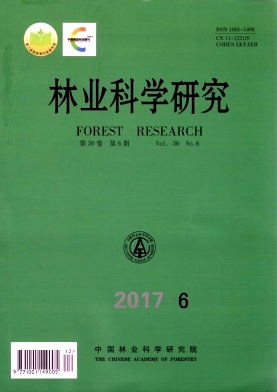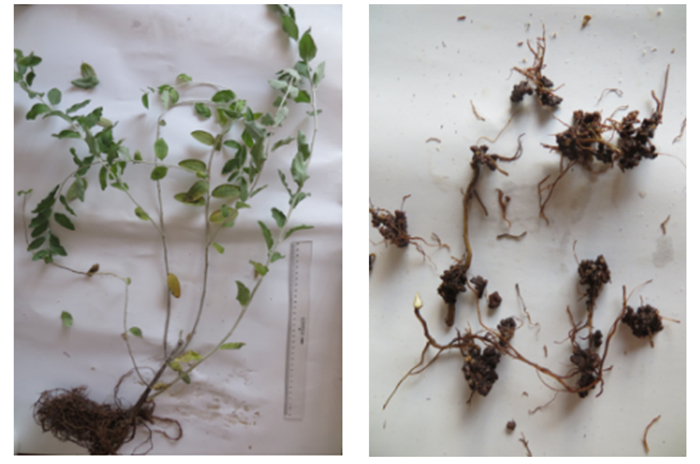-
土地盐渍化是一个世界性的生态和资源难题,据统计,全世界盐碱地面积超过8×106 km2[1]。我国盐渍土分布广泛,各种不同类型的盐碱土壤约占国土总面积的10.3%,其面积约为1×106 km2[2],主要集中在华北的黄淮海地区、东北的三江平原和西北地区的大部等干旱、半干旱地区。盐渍土作为重要的土地后备资源,亟待治理、开发和利用。通过生物措施改良盐渍土,既有生态效益,又有经济效益和社会效益,是治理、开发和利用盐渍土的重要途径,已为很多国家和地区接受和采用[3-5]。种植耐盐固氮树种是进行生物改良盐渍土的有效方法之一。耐盐树种可以在一定的盐胁迫下正常生长,又可以通过生物固氮提供自身生长所需的氮素,还可以改善土壤养分状况,有利于其它植物及微生物的生存、生长,进而促进土壤物理性状的改善,促进营建一定的植物群落。耐盐固氮树种生物固氮作用的研究也越来越受到关注。
沙枣(Elaeagnus angustifolia L.)为胡颓子科(Elaeagnaceae)胡颓子属(Elaeagnus L.)落叶乔木或小乔木[6],别名桂香柳、香柳、银柳,是我国北方生态脆弱地区分布较广的重要固氮盐土植物。沙枣根系可以与弗兰克氏菌共生形成根瘤共生体系,是木本非豆科放线菌共生固氮树种。弗兰克氏菌Frankia sp.(Hippophae)是一种共生固氮放线菌,能够侵染沙枣、沙棘等多种非豆科树种并能在其根部形成根瘤,其固定的氮可供给宿主植物需要,也是陆地生态系统中输入氮源的主要贡献者。
沙枣主要分布于地中海沿岸、亚洲西部、前苏联和印度等地,在我国主要分布在广大的西北各省区和内蒙古西部,少量分布于华北北部、东北西部,大致在北纬34°以北地区,山东、河北、天津、山西等省区也有引种栽培。沙枣具有抗风沙、耐盐渍、耐高温、耐贫瘠、易繁殖、适应性强等特点,是我国北方生态脆弱地区造林绿化、防风固沙的先锋树种,是盐碱地造林及改造干旱、沙地、荒地的优良树种之一[7-8]。沙枣作为饲料已有悠久的历史,还有酿酒、制蜜等食用用途,其花、果、枝、叶又可入药治疗烧伤、支气管炎、消化不良、神经衰弱等。沙枣是优良的造林、绿化、薪炭、防风、固沙树种,具有良好的生态、经济、食用和药用价值。
对NaCl胁迫下,沙枣种子萌发、水分与渗透调节、抗氧化防御等研究表明,沙枣具有良好的耐盐性[9-11]。沙枣能在滨海含盐量0.8%~1.2%的盐碱地正常生长,但幼苗在NaCl浓度大于100 mmol·L-1时,随NaCl浓度增大,叶片生长受抑制越来越明显[12]。沙枣适应盐渍化土壤,在硫酸盐盐土上,全盐量1.3%以下尚能生长;在硫酸盐氯化物盐土上,全盐量0.6%以下时,才适于造林;在硫酸盐氯化物盐土上,全盐量0.4%以下,才适于生长[13-15]。对沙枣盐碱地引种及造林试验表明,沙枣能在适度的盐碱胁迫下促进根瘤菌的形成[16-17]。在盐渍土上种植沙枣,不但可增加土壤中的含水量,而且可增加土壤中的空气体积和有机质含量,提高营养元素含量,降低土壤pH值,对滨海盐渍土有很好的改良效果[18-19]。在辽宁滨海盐碱地的研究显示,沙枣的最大固氮量为5.88 kg·hm-2·a-1[20]。
近年来,15N自然丰度法已逐渐成为一种应用范围较广的定量研究生物固氮的方法,在国际上日益受到重视,已广泛应用于陆地生态系统的氮循环研究中[21]。使用15N自然丰度法具有以下优势:不需要采集根瘤,不需要15N标记物,不干扰野外植物和土壤生态系统,不受取样时间和空间的限制[22-24],并且测量简单[25]。测定15N丰度即可估测固氮情况,可用于多年生木本固氮植物固氮能力的评估是其不可替代的优点[26-27]。综合目前固氮测定技术的优缺点及应用范围等,对于研究多年生木本固氮树种,15N自然丰度法是较佳的选择[28]。
研究耐盐固氮树种盐胁迫下生物固氮机理对于盐碱地生物改良中植物材料的选择和综合开发利用具有重要意义。目前在盐渍土条件下利用15N自然丰度法评价耐盐固氮树种固氮能力的研究较匮乏,林用耐盐固氮树种生物固氮方面系统、深入的研究较少。本研究通过耐盐树种的室内砂培试验,对15N自然丰度法在盐胁迫下的应用条件进行优化,确定盐渍土条件下适宜的参比植物;估测室内及野外环境中沙枣的生物固氮能力;并探讨了几种耐盐树种的氮素分配情况。本研究可以为盐渍土条件下应用15N自然丰度法研究耐盐树种生物固氮作用提供参考,为耐盐固氮树种资源综合开发利用提供理论基础。
HTML
-
B值是以空气氮为唯一氮源的固氮植物的15N相对丰度值,是植物仅通过自身固氮得到的那部分氮素。木本植物与草本植物、谷类等农作物之间具有一定的生物学差异,因此选择前人研究的草本植物作为参比植物可能不适合木本植物的研究。B值及参比植物对于应用15N自然丰度法估算生物固氮量有着重要的意义。
本研究通过沙枣不供给氮源的室内砂培试验,获得沙枣盐胁迫条件下应用15N自然丰度法时的B值。由于没有现成的参比植物,因此对于适应于重度盐度环境中的固氮植物沙枣,选取适应于中、重度盐度环境的白蜡、柽柳2种盐碱地常见非固氮植物作为备选参比植物,这些植物具有较好的抗性,耐旱、耐盐碱,根系较发达,与研究的耐盐固氮植物特性相近。
-
营养钵选用上口径27 cm、下口径17 cm、高22 cm的聚乙烯塑料盆,用无纺布将盆底排水孔覆盖防止营养液过分流失。每盆中加入等量的河砂基质(4.5 kg±50 g)。选用沙枣、柽柳(Tamarix chinensis Lour.)、白蜡(Fraxinus chinensis Roxb.)1年生温室培养实生苗。小苗移植入盆,每盆植入1株植株,视基质湿度情况,每7 d左右浇一次水,浇透盆。缓苗20 d,之后选取长势基本一致的健康植株进行试验。试验处理中盐胁迫设置1个处理水平,NaCl浓度为100 mmol·L-1,处理溶液为相应质量的NaCl溶入营养液配制而成。试验处理见表 1,每处理6个重复。试验中需要无氮营养液和有氮素营养液[29-30]。无氮营养液组成见表 2,有氮素营养液是在无氮营养液的基础上加入含氮化合物,加入的成分见表 3。试验所用药品均为分析纯。盐胁迫当天开始,参试植物沙枣(处理1)及参比植物柽柳、白蜡(处理2、3)添加含盐有氮素营养液。测B值的沙枣(处理4)添加含盐无氮营养液。首次浇灌含盐营养液时浇透盆,之后视基质湿度情况,每7 d左右浇灌1次,每盆浇灌等量含盐营养液。
处理Treatment 植物Plant 营养液Nutrient solution NaCl浓度Concentration of NaCl/(mmol·L-1) 1 沙枣E. angustifolia 有氮素营养液Nutrient solution 100 2 柽柳T. chinensis 有氮素营养液Nutrient solution 100 3 白蜡F. chinensis 有氮素营养液Nutrient solution 100 4 沙枣E. angustifolia 无氮营养液Nitrogen-free nutrient solution 100 Table 1. Design of experiments
化合物Compound 质量浓度Concentration/(mg·L-1) KH2PO4 22 KCL 155 MgSO4·7H2O 250 CaCL2·2H2O 215 EDTA Na2 18 NaNO3 30 MnSO4·H2O 1 ZnSO4·7H2O 0.25 H3BO3 0.25 CuSO4·5H2O 0.25 Na2MoO4·2H2O 0.05 Table 2. Composition of nitrogen-free nutrient solution
化合物Compound 质量浓度Concentration/(mg·L-1) Ca(NO3)2·4H2O 472.5 KNO3 253 NH4NO3 40 Table 3. Composition of nutrient solution complemented
由于土壤养分状况、水分、温度等环境条件均会对植物的固氮能力产生影响,因此本试验采用室内盆栽的方式进行,试验地点为中国林业科学研究院温室。试验条件为自然光周期,温度控制在白天25℃左右,晚上20℃左右,相对湿度70%~80%,CO2浓度为360~370 μmol·mol-1。
-
首次盐胁迫处理记为0 d,之后第30 d时,取样测定。
(1) 叶中15N丰度值。
取各处理植株各枝条上嫩叶,各重复混合后,105℃下杀青10 min,80℃下烘干48 h,粉碎过0.25 mm筛,样品混合均匀,Flash EA1112 HT元素分析仪及DELTA V Advantage同位素比率质谱仪(美国Thermo Fisher Scientific公司)分别测定15N原子丰度。样品15N相对丰度:
其中δ15N为样品15N相对丰度,atom%15N(sample)为样品15N原子丰度,atom%15N(standard)为大气标准15N原子丰度(0.366 3%)。
(2) 固氮植物的生物固氮贡献。
其中%Ndfa表示植株体内来自大气中的那部分氮,δ15Nref表示参比植物15N相对丰度值,δ15Nfixing-plant表示固氮植物15N相对丰度值,B值表示以空气氮为唯一氮源的固氮植物的15N相对丰度值。
(3) 叶面积、株高和生物量。
采用Yaxin-1241叶面积仪(北京雅欣理仪科技有限公司)测定上述植株树叶样品的叶面积。
测定上述参试植株株高,以植物根茎联合处为起点到主茎顶端最高点的距离。
对参试植物沙枣、柽柳、白蜡(处理1-3)进行取样,取根、茎、叶,在105℃下杀青1 h,80℃下烘干至恒质量,分别称质量。
植株总生物量=根生物量+茎生物量+叶生物量
(4) 植物的碳、氮和磷含量植株含碳质量百分率由Vario EL Ⅲ元素分析仪测定。
上述植株根、茎、叶样品,用Vario EL Ⅲ元素分析仪(德国Elementar公司)分别测定各器官含氮质量百分率。
植株氮的含量=根生物量×根含氮质量百分率+茎生物量×茎含氮质量百分率+叶生物量×叶含氮质量百分率
植株含磷的质量百分率通过H2SO4-H2O2消煮-钼锑抗比色法测定。
(5) 生长季生物固氮量和吸氮量。
植株生长季内的生物固氮量[31]=植株氮的含量×生物固氮百分率(%Ndfa)
植物生长季内的吸氮量=植株生物固氮量×固氮植物数量
-
试验地点为天津市大港区滨海耐盐碱植物示范园。土壤pH8.5,土壤含盐量0.4%。以5年生耐盐树种沙枣、柽柳和1年生白蜡为研究对象,对沙枣、柽柳和白蜡当年生枝叶进行取样,每棵树均在各方向取样,每树种取6株重复,取样时间为7月上旬。
各树种样品105℃下杀青10 min,80℃下烘干48 h,粉碎过0.25 mm筛,样品混合均匀,稳定同位素质谱仪分别测定15N原子丰度。计算样品15N相对丰度及沙枣的生物固氮百分率(%Ndfa),计算方法同前述。
1.1. 室内砂培试验
1.1.1. 培养方法及条件
1.1.2. 测定项目及方法
1.2. 野外沙枣生物固氮能力测定
-
首次盐胁迫处理后第30 d取样,固氮植物沙枣生长情况及其根瘤见图 1。由图可看出,沙枣茎、叶及根长势良好,根须较密集,根上长有较多根瘤,满足了本试验中沙枣植株必须培养出根瘤以进行生物固氮的要求。
-
通过砂培试验测得的植物15N相对丰度(表 4)。沙枣的B值为-1.41‰。
植物Plant 营养液Nutrient solution 15N相对丰度(±<0.2‰)δ15N/‰ 沙枣E. angustifolia 有氮素营养液Nutrient solution 0.20 柽柳T. chinensis 有氮素营养液Nutrient solution 2.37 白蜡F. chinensis 有氮素营养液Nutrient solution 1.99 沙枣E. angustifolia 无氮营养液Nitrogen-free nutrient solution -1.41 Table 4. Results of δ15N
以试验测定的B值为参数,分别以柽柳、白蜡为参比植物计算盐胁迫下沙枣生物固氮百分率结果见表 5。由表 5可知,以柽柳、白蜡为参比植物估测的沙枣生物固氮百分率分别为57.41%和52.65%,相差为4.76%。当计算得到的%Ndfa小于30%,或者参比植物的δ15N值小于4‰时;当%Ndfa大于70%,或者参比植物的δ15N值大于6‰时,参比植物的影响可以忽略[32-33]。由表 4看出,试验参比植物的δ15N值均小于4‰。因此在试验条件下,应用15N自然丰度法估测沙枣的生物固氮能力时,柽柳和白蜡均可作为参比植物。
植物Plant 参比植物Reference plant 差值Difference 均值Mean value 柽柳T. chinensis 白蜡F. chinensis 沙枣E. angustifolia 57.41 52.65 4.76 55.03 Table 5. Results of%Ndfa
% -
温室砂培条件下,以2.1.2测得的沙枣B值为参数,以柽柳和白蜡为参比植物测定沙枣的生物固氮百分率%Ndfa,取表 5中测定的均值55.03%,结合生物量、含氮量等数据,测定沙枣的生物固氮量。
实验结果得出,沙枣单株植株在试验生长季内的生物固氮量平均为0.30 g。砂培试验处理1的所有沙枣植株在试验生长季内的总吸氮量为1.80 g。
-
以砂培试验测定的沙枣B值为参数,以柽柳、白蜡为参比植物,对野外中度盐渍环境中的沙枣进行生物固氮能力测定,见表 6。由表可知,以柽柳、白蜡为参比植物测得的沙枣生物固氮百分率分别为67.36%和72.01%,相差4.65%,平均生物固氮百分率为69.69%。
参比植物Reference plant 柽柳T. chinensis 白蜡F. chinensis 生物固氮百分率%Ndfa 67.36 72.01 差值Difference 4.65 均值Mean value 69.69 Table 6. %Ndfa of E. angustifolia
% -
(1) 树种含氮量参试耐盐树种沙枣、柽柳、白蜡植株含氮量见表 7。由表看出,试验植株含氮量在9.98~24.77 mg·g-1之间,沙枣含氮量最高且与其它树种差异显著(P<0.05)。试验植株氮的含量在0.11~0.54 g之间,沙枣植株氮的含量最高且与其它树种差异显著(P<0.05)。参试植株生物量在6.67~34.47 g之间,白蜡植株生物量最高且与其它树种差异显著(P<0.05)。参试各树种株高在46.65~118.75 cm之间,白蜡株高最高且与其它树种差异显著(P<0.05)。各树种叶面积在151.12~665.23 cm2之间,白蜡植株叶面积最大且与其它树种差异显著(P<0.05)。
指标Index 沙枣E. angustifolia 柽柳T. chinensis 白蜡F. chinensis 植株含氮量
Nitrogen content of plant/(mg·g-1)24.77±0.24a 17.25±0.71b 9.98±0.10c 植株氮的含量
Nitrogen quality in plant/g0.54±0.02a 0.11±0.01c 0.34±0.02b 生物量Biomass/g 21.69±1.56b 6.67±0.33c 34.47±1.24a 株高Plant height /cm 82.00±2.04b 46.65±2.11c 118.75±4.54a 叶面积Leaf area/cm2 390.32±13.13b 151.12±7.06c 665.23±32.65a 注:数值=平均值±标准误(n=6),采用邓肯氏新复极差检验法(DMRT法)进行多重比较,行中相同字母表示差异不显著,检验的显著性水平为P=0.05。Note:Values are mean ± S.E. (n=6). Values in a low followed by same letters are not significantly different (p=0.05) according to duncan’s multiple comparison (DMRT). Table 7. The growth indexes of plants tested
(2) 树种氮素分配参试耐盐树种沙枣、柽柳、白蜡植株氮素分配情况见表 8。由表看出,各树种植株各器官中叶含氮量最高,在21.03~33.21 mg·g-1之间,其次为根、茎。参试植株茎含氮量在7.33~21.57 mg·g-1之间,根含氮量在13.59~25.51 mg·g-1之间,沙枣叶、茎、根含氮量均最高且均与其它树种差异显著(P<0.05)。
名称Item 沙枣E. angustifolia 柽柳T. chinensis 白蜡F. chinensis 叶含氮量Nitrogen content of leaf/(mg·g-1) 33.21±1.51a 31.78±1.51b 21.03±1.07c 茎含氮量Nitrogen content of of stem/(mg·g-1) 21.57±1.03a 10.21±0.46b 7.33±0.36c 根含氮量Nitrogen content of root/(mg·g-1) 25.51±1.24a 19.21±0.92b 13.59±0.62c 叶氮素分配比例Nitrogen distribution ratio in leaf/% 20.75±1.02c 51.81±2.02a 23.88±0.77bc 茎氮素分配比例Nitrogen distribution ratio in stem/% 42.93±2.01b 37.22±1.84b 52.38±1.40a 根氮素分配比例Nitrogen distribution ratio in root/% 36.32±1.75a 10.97±0.42c 23.74±1.04b 叶氮的含量Nitrogen quality in leaf/g 0.11±0.01a 0.06±0.00b 0.08±0.01ab 茎氮的含量Nitrogen quality in stem/g 0.23±0.01ab 0.04±0.00c 0.18±0.01b 根氮的含量Nitrogen quality in root/g 0.20±0.01a 0.01±0.00c 0.08±0.01b 单位叶面积氮含量Nitrogen content per unit leaf area/(g·cm-2) 0.28±0.01b 0.38±0.02a 0.13±0.01c 注:数值=平均值±标准误(n=6),采用邓肯氏新复极差检验法(DMRT法)进行多重比较,行中相同字母表示差异不显著,检验的显著性水平为P=0.05。
Note:Values are mean ± S.E. (n=6). Values in a low followed by same letters are not significantly different (p=0.05) according to duncan’s multiple comparison (DMRT).Table 8. Nitrogen distribution of plants tested
沙枣和白蜡植株体内的氮素分配到茎中的最多,分别占植株含氮量的42.93%和52.38%。沙枣和白蜡植株茎生物量相对较大,因此茎的氮素分配比例相对较大。柽柳植株体内的氮素分配到叶中的最多,占植株含氮量的51.81%。沙枣的氮素主要存在于茎中,其次为根、叶;柽柳的氮素主要存在于叶中,其次为茎、根;白蜡的氮素主要存在于茎中,其次为叶、根。参试植物叶氮的含量占植株氮的含量的20.75%~51.81%,柽柳叶氮素分配比例最高且与其它树种差异显著(P<0.05)。参试植物茎氮的含量占植株氮的含量的37.22%~52.38%,白蜡茎氮素分配比例最高且与其它树种差异显著(P<0.05)。参试植物根氮的含量占植株氮的含量的10.97%~36.32%,沙枣根氮素分配比例最高且与其它树种差异显著(P<0.05)。
试验植株叶氮的含量在0.06~0.11 g之间,沙枣叶氮的含量最高;植株茎氮的含量在0.04~0.23 g之间,沙枣茎氮的含量最高;植株根氮的含量在0.01~0.20 g之间,沙枣根氮的含量最高且与其它树种差异显著(P<0.05)。参试沙枣植株各器官中茎氮的含量最高,其次为根、叶;柽柳叶氮的含量最高,其次为茎、根;白蜡茎氮的含量最高,其次为叶和根。
参试树种单位叶面积氮含量在0.13~0.38 g·cm-2之间,柽柳单位叶面积氮含量最高且与其它树种差异显著(P<0.05)。
(3) 室内盐胁迫下耐盐树种碳、氮、磷含量比参试耐盐树种沙枣、柽柳、白蜡植株碳、氮、磷含量比见表 9。由表看出,试验植株氮/碳含量比为0.02~0.05之间,沙枣氮/碳含量比最高。植株各器官中叶氮/碳含量比最高,其次为根、茎。植株叶氮/碳含量比为0.05~0.09之间,柽柳叶氮/碳含量比最高。植株茎氮/碳含量比为0.02~0.05之间,植株根氮/碳含量比为0.03~0.06之间,沙枣茎及根氮/碳含量比最高。
名称Item 沙枣E. angustifolia 柽柳T. chinensis 白蜡F. chinensis 植株氮/碳含量比N/C Nitrogen and carbon content ratio of plant 0.05 0.04 0.02 叶氮/碳含量比N/C Nitrogen and carbon content ratio of leaf 0.07 0.09 0.05 茎氮/碳含量比N/C Nitrogen and carbon content ratio of stem 0.05 0.02 0.02 根氮/碳含量比N/C Nitrogen and carbon content ratio of root 0.06 0.04 0.03 植株氮/磷含量比N/P Nitrogen and phosphorus content ratio of plant 19.20 10.59 11.09 叶氮/磷含量比N/P Nitrogen and phosphorus content ratio of leaf 21.94 12.08 16.90 茎氮/磷含量比N/P Nitrogen and phosphorus content ratio of stme 17.94 10.08 9.85 根氮/磷含量比N/P Nitrogen and phosphorus content ratio of root 19.41 7.89 10.38 Table 9. Carbon, nitrogen, and phosphorus content ratio of plants tested
试验植株氮/磷含量比为10.59~19.20之间,沙枣氮/磷含量比最高。植株叶氮/磷含量比为12.08~21.94之间,茎氮/磷含量比为9.85~17.94之间,根氮/磷含量比为7.89~19.41之间,沙枣叶、茎及根的氮/磷含量比最高。
-
野外中度盐渍环境中耐盐树种叶的碳、氮/磷含量比见表 10。由表看出,参试树种叶氮/碳含量比为0.059~0.081之间,叶氮/磷含量比为11.54~17.68之间,沙枣叶的氮/碳含量比及氮/磷含量比均最高。
参数Item 沙枣E. angustifolia 柽柳T. chinensis 白蜡F. chinensis 叶氮/碳含量比N/C Nitrogen and carbon content ratio of leaf 0.081 0.059 0.078 叶氮/磷含量比N/P Nitrogen and phosphorus content ratio of leaf 17.68 12.20 11.54 Table 10. Carbon, nitrogen, and phosphorus content ratio of plant leaves in moderate salinity environment field
2.1. 参比植物的选择
2.1.1. 室内砂培试验根瘤情况
2.1.2. B值及参比植物
2.2. 盐胁迫下沙枣生物固氮能力
2.2.1. 室内盐胁迫下沙枣生物固氮量
2.2.2. 野外中度盐度下沙枣生物固氮能力
2.3. 盐胁迫下耐盐树种氮素分配
2.3.1. 室内砂培试验
2.3.2. 野外试验
-
15N自然丰度法在生物固氮研究中的应用、豆科植物生物固氮以及植物盐胁迫下的耐盐性等研究已较成熟[34-35],但目前15N自然丰度法应用于盐胁迫条件下的研究资料还较少,尤其是应用于盐渍土条件下评价林用耐盐木本非豆科放线菌共生固氮树种固氮能力的研究较匮乏。15N自然丰度法具有方便简单等很多优势,本文以木本非豆科放线菌共生固氮树种沙枣为研究对象,对15N自然丰度法在盐胁迫条件下的适用性进行了探索,可以为盐胁迫条件下利用15N自然丰度法研究生物固氮作用提供计算参数和理论基础。
确定B值及参比植物等15N自然丰度法的应用条件,使其能够应用于盐渍土壤条件下植物生物固氮能力的评估,是探讨耐盐固氮树种对盐碱地生物改良作用的基础理论研究。沙枣等植物根系与弗兰克氏菌共生形成根瘤共生体系,是非豆科放线菌共生固氮树种;大部分豆科树种根系与根瘤菌属的细菌共生形成根瘤共生体系,是豆科根瘤菌共生固氮树种。不同生物固氮机制类型的耐盐树种在不同盐度胁迫条件下的生物固氮能力是否存在差异,其对不同盐胁迫的响应如何;不同固氮类型的耐盐树种在盐渍土条件下和非盐胁迫条件下的生物固氮能力是否存在差异等等科学问题,还需要今后做进一步的系统研究和探讨。除柽柳和白蜡外,沙枣适宜的参比植物还有哪些,其它生物固氮树种或其他不同生物固氮类型的植物所适宜的参比植物如何选择,需要后续的研究探讨。
耐盐固氮树种是一类良好的生物改良盐碱地的植物资源,在多种盐胁迫水平或重度盐度条件下,应用15N自然丰度法评价多种不同生物固氮类型的耐盐固氮树种的生物固氮能力还需要今后深入的研究探讨。
-
(1) 温室环境中,盐胁迫下的室内砂培试验表明,柽柳和白蜡可作为参比植物用于在试验的盐渍土壤条件下利用15N自然丰度法估算沙枣的固氮能力。试验条件下,以空气氮为唯一氮源的耐盐固氮树种沙枣的15N相对丰度值B值为-1.41‰。试验的盐胁迫条件下沙枣的生物固氮百分率为55.03%,野外土壤中度盐渍环境中,沙枣生物固氮百分率为69.69%。
(2) 参试植物中,沙枣植株及其叶、茎、根含氮量最高且与其它树种差异显著(P<0.05);沙枣植株氮/碳含量比及氮/磷含量比最高;沙枣叶、茎及根的氮/磷含量比最高。野外中度盐渍环境中沙枣叶的氮/碳含量比及氮/磷含量比均最高。
(3) 试验测定的沙枣生物固氮百分率均大于50%,沙枣植株及其叶、茎、根含氮量均较高,且室内及野外环境中沙枣植株氮/碳含量比及氮/磷含量比均较高,表明沙枣在盐胁迫下的固氮能力较强,是可应用于盐渍土生物改良的优良树种。野外环境中测定的沙枣生物固氮百分率高于室内培养的,可能与土壤、大气、水分、光照及温湿度等环境条件以及植物生长时间、体内固氮酶等因素有关。







 DownLoad:
DownLoad: